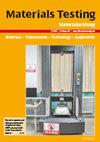Influence of Ti and Nb addition on the microstructure, mechanical, and machinability properties of 316L stainless steel fabricated by powder metallurgy
IF 3.5
4区 材料科学
Q2 MATERIALS SCIENCE, CHARACTERIZATION & TESTING
引用次数: 1
Abstract
Abstract In this study, titanium and niobium element powders in determined amounts (0.25 and 0.5 wt%) were added into the 316L stainless steel matrix by means of powder metallurgy (PM) technology, either singly or in pairs, and the desired composition was obtained as a powder mixture. The powders used in the study were cold pressed tensile sample molds prepared in ASTM 8 M standards, unidirectionally cold pressed under 700 MPa compression pressure and formed into blocks. After pressing, the raw strength samples were sintered in an atmosphere-controlled tube furnace at 1325 °C for 2 h in an argon atmosphere. The microstructure and mechanical properties of the produced PM steels were characterized by optical microscope, SEM, EDS, and tensile test. The results showed that the stainless-steel samples with 0.25(Ti–Nb) added composition to 316L stainless steel had the highest yield strength and tensile strengths. However, with the addition of 0.5Ti, 0.5Nb, and 0.5(Ti–Nb) to 316L stainless steel, a decrease was observed in the mechanical properties. Moreover, the MQL machining is better on the machining output such as surface roughness and cutting temperature than dry machining in terms of a sustainable machining process.Ti和Nb添加对粉末冶金316L不锈钢显微组织、力学性能和切削性能的影响
本研究采用粉末冶金(PM)技术,将一定量的钛和铌元素粉末(0.25和0.5 wt%)单独或成对地加入到316L不锈钢基体中,得到所需的组合物粉末混合物。研究中使用的粉末是按照ASTM 8 M标准制备的冷压拉伸样模,在700 MPa的压缩压力下单向冷压成型。压制后,在气氛控制的管式炉中,在1325 °C的氩气气氛中烧结2 h。采用金相显微镜、扫描电镜、能谱仪和拉伸试验等方法对制备的PM钢进行了显微组织和力学性能表征。结果表明,在316L不锈钢中添加0.25(Ti-Nb)成分的不锈钢试样具有最高的屈服强度和抗拉强度。然而,在316L不锈钢中添加0.5 ti、0.5 nb和0.5(Ti-Nb)后,力学性能有所下降。此外,就可持续加工过程而言,MQL加工在表面粗糙度和切削温度等加工输出方面优于干式加工。
本文章由计算机程序翻译,如有差异,请以英文原文为准。
求助全文
约1分钟内获得全文
求助全文
来源期刊

Materials Testing
工程技术-材料科学:表征与测试
CiteScore
4.20
自引率
36.00%
发文量
165
审稿时长
4-8 weeks
期刊介绍:
Materials Testing is a SCI-listed English language journal dealing with all aspects of material and component testing with a special focus on transfer between laboratory research into industrial application. The journal provides first-hand information on non-destructive, destructive, optical, physical and chemical test procedures. It contains exclusive articles which are peer-reviewed applying respectively high international quality criterions.
 求助内容:
求助内容: 应助结果提醒方式:
应助结果提醒方式:


